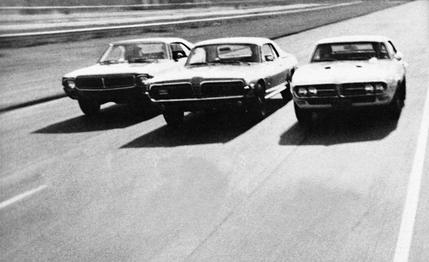
 Archived Comparison
Archived Comparison
They are Ford's better ideas, Pontiac's dream of a wide-tracking life, Chevrolet's sports department stars, American Motors' Image changers and the ongoing beat of Chrysler Corporation.
They are the six sporty cars: AMC Javelin, Barracuda, Camaro, Cougar, Firebird and Mustang; and they have taken the country by storm.
But in 1964/5, when Ford introduced Mustang as the first of the sporty cars with the largest advertising budget ever allocated to a single product, the consensus in Detroit was that another Edsel had been born. Ford was leading with its chin again in the rough and tumble marketplace, and solid, staid and unspectacular Chevrolet was going to flatten Dearborn for once and for all. Part of this feeling came from Detroit's surprise—a sporty car couldn't work because it was new and unexpected. After all, everybody said, the car was nothing more than an impractical Falcon—only two people could ride in it, there was almost no trunk space, and, horror of horrors, the styling was radical. Oh, some of the kids might go for the long-hood, short-deck look, and maybe even the sports car nuts might latch onto the idea, but that was about it and doomsday was just around the corner.
Within four months those oracles were watching 65-year-old retired druggists, school teachers and just about the whole population of every semi-fashionable suburb in the country standing in line to buy a Mustang—and the rush was on in Detroit.
Opinion that the Mustang would be a failure was so generally held in Detroit that Ford was able to hold onto the sporty car market virtually unchallenged for a year and a half while everybody else was spending precious months tooling up to get a piece of the action. Plymouth was the first to follow Ford's lead with the Barracuda—a car that was hurried into production and showed it, ending up looking more like a beached whale than its namesake.
But by 1966 Ford had plenty of company. Plymouth had a new, sexy Barracuda; Chevy made its move with Camaro and was followed a few months later by Pontiac with the Firebird. Ford's sister division, Lincoln-Mercury, jumped on the bandwagon with the Cougar. Then, this year, AMC brought out the Javelin. And now, three generations and three years later, almost everyone but Checker and Excalibur is building a sporty car.
And the American people can't seem to get enough of the idea. Thus far, none of the manufacturers has reason to regret his entry into the market—and the doomsday criers are now nodding wisely and saying it had to happen; the concept is irresistible with its appeal stretching across the traditional age and economic boundaries.
Everybody from street racer to ad executive to country doctor has been caught up in the fascination of having a car that feels lithe and responsive, and offers sleek good looks to put a little sparkle in the image. And, by offering a list of options as long as a six-year-old's Christmas list, Detroit has made it possible for every buyer to order his own car; from the super econ-o 6-cylinder versions with the 3-speed manuals and skinny tires for little old ladies, all the way to the double-zoomy 427 V-8s with heavy-duty 3-speed automatics, styled wheels, fat tires and metal-flake paint jobs. There's a sporty car for everyone out there in buyerland.
The result is infinitely important to the future of the car: even though there are a couple of million sporty cars running around on the roads, the individual buyer considers his car to be unique—something he has had a part in designing—and something that sets him apart from those stodgy clowns who march down to the local dealer every three years and drive out in another dumb 4-door sedan.
So all the world loves a sporty car and no one more than C/D. Because of their relatively compact dimensions, the sporty cars handle better than most other Detroit products; and all of them, to a greater or lesser degree, have been designed to be driven rather than to haul parcels down to the post office or to serve as odd shaped school buses. These are real cars and, with the exception of the Corvette, AMX and some of the Super Cars, they are the industry's only attempt to build something that will appeal to people who enjoy driving.
So the sporty cars were a natural for a patented Car and Driver Comparison Test—except every time we scheduled one, a new car appeared on the horizon and we had to postpone testing. But now there are six; Ford, Chrysler, GM and AMC have their cards on the table and have anted up.